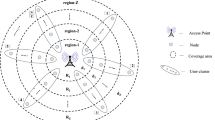Abstract
IEEE 802.11ah task group has developed a new wireless local area network (WLAN) technology, sub 1GHz (S1G) WLAN, for future Internet of Things (IoT) environments. Because of the superior propagation feature of S1G frequency band, S1G WLAN can provide very long transmission range, wild coverage, and support more than 8000 devices. In order to alleviate the high collision probability raised in the dense network environment, S1G WLAN adopts an restricted access window (RAW) mechanism. However, as the time slots of RAW are allocated without any consideration of traffic load of devices, the medium resource might be inefficiently used. In addition, devices belonging to a same group have to contend for channel, and thus severe collisions may occur in a large size group. In this paper, we propose a sequential transmission scheme, which provides an efficient way of source management in the S1G WLANs by considering the traffic loads and allocating channel access times of the devices. Through conducting mathematical analysis and performing simulations, we prove that our proposed protocol can enhance the performance of the S1G WLANs for the IoT environments.









Similar content being viewed by others
References
Miorandi, D., Sicari, S., De Pellegrini, F., & Chlamtac, I. (2012). Internet of things: Vision, applications and research challenges. Ad Hoc Networks, 10(7), 1497–1516.
Borgia, E. (2014). The Internet of Things vision: Key features, applications and open issues. Computer Communication, 54, 1–31.
Hazmi, A., Rinne, J., & Valkama, M.(2012). Feasibility study of IEEE 802.11 ah radio technology for IoT and M2M use cases. In Globecom Workshops (GC Wkshps) (pp. 1687–1692), Anaheim, CA.
Bel, A., Adame, T., Bellalta, B., Barcelo, J., Gonzalez, J., & Oliver, M.(2014). CAS-based channel access protocol for IEEE 802.11ah WLANs. In European Wireless (pp. 1-6), Barcelona.
Park, M.(2013). Specification framework for TGah, doc.: IEEE 802.11-11/1137r15.
Park, M. (2015). IEEE 802.11ah: Sub 1GHz license-exempt operation for the internet of things. IEEE Communications Magazine, 53(9), 145–151.
IEEE 802.11ah/D10.0, Draft for Information Technology Telecommunications and Information Exchange between Systems-Local and Metropolitan Area Networks-Specific Requirements-Part 11: Wireless LAN Medium Access Control (MAC) and Physical Layer (PHY) Specifications-Amendment 2: Sub 1 GHz License Exempt Operation, September 2016.
Khorov, E., Lyakhov, A., Krotov, A., & Guschin, A. (2015). A survey on IEEE 802.11ah: An enabling networking technology for smart cities. Computer Communications, 58(1), 53–69.
Ji, B., Song, K., Hu, Y., & Chen, H. (2014). Cooperative transmission mechanisms in next generation WiFi: IEEE 802.11ac. International Journal of Distributed Sensor Networks, 2014(1), 1–12.
Aust, S., Prasad, R.V., & Niemegeers, I.G.(2012). IEEE 802.11ah: Advantages in standards and further challenges for sub 1 GHz Wi-Fi. In Proceedings of IEEE International Conference on Communications (ICC) (pp. 6885–6889). Ottawa, Canada.
Adame, T., Bel, A., Bellalta, B., Barcelo, J., & Oliver, M. (2014). IEEE 802.11ah: The Wi-Fi approach for M2M communications. Wireless Communications, 21(6), 144–15.
Adame, T., Bel, A., Bellalta, B., Barcelo, J., & Oliver, M.(2013). Capacity analysis of IEEE 802.11ah WLANs for M2M communications. Lecture Notes in Computer Science (pp. 139–155). Springer.
Sun, W., Choi, M., & Choi, S. (2013). IEEE 802.11ah: A long range 802.11 WLAN at Sub 1 GHz. Journal of ICT Standardization, 1(1), 83–108.
Yang, Y., & Roy, S. (2014). Grouping-based MAC protocols for EV charging data transmission in smart metering network. IEEE Journal on Selected Areas in Communications, 32(7), 1328–1343.
Damayanti, W., Kim, S., & Yun, J.-H. (2016). Collision chain mitigation and hidden device-aware grouping in large-scale IEEE 802.11ah networks. Computer Networks, 108(5), 296–306.
Yoon, S.-G., Seo, J.-O., & Bahk, S. (2016). Regrouping algorithm to alleviate the hidden node problem in 802.11ah networks. Computer Networks, 105(5), 22–32.
Maduen̄o, G. C., Stefanović, Č., & Popovski, P. (2016). Reliable and efficient access for alarm-initiated and regular M2M traffic in IEEE 802.11ah Systems. IEEE Internet of Things Journal, 3(5), 673–682.
Park, C., Hwang, D., & Lee, T.-J. (2014). Enhancement of IEEE 802.11ah MAC for M2M communications. IEEE Communications Letters, 18(7), 1151–1154.
Zhao, Y., Yilmaz, O. N. C., & Larmo, A. (2015). Optimizing M2M energy efficiency in IEEE 802.11ah. IEEE Globecom Workshops (GC Wkshps), San Diego, CA, USA, 18(7), 1–6.
Bianchi, G. (2000). Performance analysis of the IEEE 802.11 distributed coordination function. IEEE Journal on Selected Areas in Communications, 18(3), 535–547.
Acknowledgements
This work was supported by Natural Science Foundation of the Jiangsu Higher Education Institutions(16KJB520044), Basic Science Research Program of the National Research Foundation of Korea (2013R1A1A2008855), and in part by research grant of Kwangwoon University in 2016.
Author information
Authors and Affiliations
Corresponding author
Rights and permissions
About this article
Cite this article
Lei, X., Rhee, S.H. Performance Improvement of Sub 1 GHz WLANs for Future IoT Environments. Wireless Pers Commun 93, 933–947 (2017). https://doi.org/10.1007/s11277-017-3947-3
Published:
Issue Date:
DOI: https://doi.org/10.1007/s11277-017-3947-3




